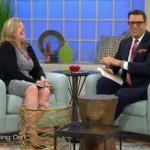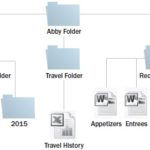NYU Journalism Student Writes About Me and the Digital Divide
An immense digital divide exists between those born into today’s technology generation and those who did not grow up using a computer, but Abby Stokes believes that anyone can learn to use a computer, no matter what age.
“I refer to anyone over the age of 40 as a digital immigrant and anyone under 40 a digital native,” says Abby Stokes, a professional actor, turned teacher, turned author. “Any immigrant, even if the food is good, is never home in a country that is not theirs.” This is one of the principle tenets Stokes uses to “demystify” computers, a process developed through the inspiration of her own mother and presented in her book Is This Thing On: A Handbook for Latebloomers, Technophobes, and the Kicking & Screaming. Her patient approach of teaching details has allowed her to help over 135,000 individuals, throughout seventeen years, most of them senior citizens, to make the move and become connected in this digital age.
The Pew Research Center’s “Generations 2010” report, by Kathryn Zickuhr, measures Internet use among six different groups and the impact on American life. Statistics show that 58 percent of the Silent Generation (ages 65-73) use the Internet and account for 5 percent of the total online population. 30 percent of individuals in the G.I. Generation (age 74+) use the Internet, which accounts for 3 percent of the total online population. While a lack of money and resources contribute to this dearth of seniors online, one fact remains certain—learning to operate some of today’s technology can be a source of great frustration, even for the most plugged-in people.
“It’s exasperating,” said Marion Matthews, a New Yorker who has tried many different approaches to learning e-mail and the Internet. “I’ve learned how to use a computer through different ways and people over time but e-mail is so difficult.”
It may be a failure of design or a fault in one’s own internal wiring, but those who have not grown up using computer technology simply have a difficulty understanding it. That is where Abby Stokes steps in.
“I think of a computer as a car,” says Stokes, in a presentation at the New York Public Library’s Senior Jamboree, held on May 5th at the 23rd Street Epiphany Library branch, “I can drive a car, but I don’t need to know how it works to operate it.”
A December 2009 Nielsen study reported that from 2004, the number of seniors using the Internet increased more than 55 percent, from 11.3 million users in November 2004 to 17.5 million in November 2009, and the numbers continue to grow. The New York Public Library has increased these statistics through programming.
“We have about 90 branches and we’ll send Abby to ten different ones to give her presentation, and they love it,” says Brigid Cahalan, a Librarian for the New York Public Library who schedules Abby at events in various NYPL locations around the city. “Abby makes them realize that they can do it.”
Programming at the New York Public Library has proven effective and inspirational to many who want to learn but can’t afford expensive or complicated methods.
“We’ve had people coming in all day since we started at 10:30, like ‘When is the computer presentation? When is she coming? I saw her at Kips Bay, I saw her at Morningside Heights,” says Epiphany Library head librarian Elissa Kling, who organized the Jamboree on May 5th.
Stokes also works with Older Adults Technology Services, OATS, a non-profit organization that sees technology as a way to improve the lives of older adults.
“It can be very difficult for an older person, who is supposed to be older and wiser, to cope with the feeling of not knowing how to use technology or to feel like they are being left out,” says Renee Coronado Martinez, Director of Digital Communities for OATS, who has worked closely with Stokes to teach computers to seniors in the New York area. “Technology is so youth focused, but the more older adults are online and involved in discussions, the more our society sees them, understands them and values them.”
The average computer-user does not realize that the smallest function, like using a mouse or typing on a keyboard, is difficult for a digital immigrant. Stokes understands this and explains every step, from turning on the computer, to ultimately learning how to visit her website. Shirley Farnsworth, at seventy-eight years old, has seen her computer skills evolve.
“I was given a computer by my kids, but I had no idea how it operated at all. The classes they give in the library are lousy. They assume you know something,” she says. “I didn’t know anything. I didn’t know when they said touch the mouse there’s the left side and the right side.”
For Farnsworth, like many seniors, learning to use a computer and the Internet opened the door to new opportunities. Born into a family of actors, and once a singer herself, Farnsworth found a way to satisfy her artistic desires through the computer after her singing voice was destroyed from a colon operation gone awry.
“I found a woman in a forum who produced free graphics. [The graphics] helped me create images and put them together to make cards, and I’m sort of noted for it,” she said. “It’s been a joyous thing, and becoming more disabled all the time it really helps me.”
Many seniors want to learn but just haven’t found the correct method to truly understand that they are in fact capable of learning to use a computer.
“I bought a couple of Windows 7 books for seniors but they really didn’t seem to help me very much so I didn’t seem to make much progress after my initial start.,” said Larry Ainslee, whose wife found Stokes’ book after a serious of discouraging attempts to learn to use a computer.
Abby Stokes, despite no formal training or instruction, made a business out of helping people realize that they can do what she does.
“I didn’t go to college, I didn’t take a class on computers,” she says, surprised at her own accomplishments, “If an offer comes your way, the answer should be yes. I can’t fly a plane but I could probably learn how to fly a plane.”
– Elan H. Bird




